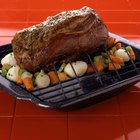
Chicken and turkey are much-loved for their culinary versatility, but not all of the bird gets an equal share of the love. Few cooks have a favorite recipe using the giblets, aside for mincing them up and using them in gravy. That's especially true of the tough, gristly gizzards, which are best after long, slow cooking. They have a firm, tender texture and delicate chicken flavor that lends itself well to salads, soups, sandwiches and other preparations. Most cooks use one of two ways to tenderize gizzards, both using low heat and long cooking times.
Braising Your Gizzards
Step 1
Rinse the gizzards under cold water, reaching into their crevices with your fingertips to get out any grit that might have remained behind when they were cleaned and packaged. Part of the gizzard is covered by a sheath of silverskin, a tough grey connective tissue. Slip the tip of a thin, sharp knife under the silverskin and peel it away from the underlying muscle.
Step 2
Arrange the gizzards in a slow cooker or casserole dish, along with onions, garlic and any other aromatic ingredients you wish. Season them with salt and pepper; then add enough chicken broth, water or wine to cover them.
Step 3
Cook the gizzards at your slow cooker's "Low" setting for 4 to 5 hours, until they're tender and not chewy when you taste a sample slice. In the oven, cook at 275 to 300 degrees Fahrenheit for the same length of time. Turkey gizzards are larger than chicken gizzards and will take longer to cook.
Step 4
Remove the gizzards from the braising liquid and transfer them to a bowl. Serve them hot with a sauce made from the cooking liquid, or cool them and use the cooked gizzards as an ingredient in other recipes.
Confit Your Gizzards
Step 1
Clean your gizzards under cold running water, removing any residual grit from inside. Dry them carefully; toss them with coarse salt and any other seasonings you wish. Cover the gizzards and refrigerate them overnight.
Step 2
Rinse the seasonings from the gizzards and pat them dry. Place them in the crock of a small slow cooker or in a heatproof casserole dish. Pour in enough rendered duck fat, chicken fat or lard to completely cover the gizzards. Gently cook the gizzards for 5 to 6 hours on your slow-cooker's "Low" setting or in a preheated oven at 225 degrees Fahrenheit for 2 to 3 hours.
Step 3
Cool the gizzards in their protective layer of fat; then refrigerate them. If you don't wish to store them in the casserole dish, transfer them first to a clean heatproof storage container with a lid.
Step 4
Remove gizzards from the fat as needed, heating them gently to melt the fat and then wiping it away with a paper towel.
Related Articles

How Long Can You Cook Beef Ribs at 300 ...

How to Cook Barbecue Chicken Drumsticks ...

How to Cook Freezer-Burnt Pork Chops

How to Cook a Frozen Beef Patty ...

Can I Stop Cooking a Chicken Halfway & ...

How to Cook Venison Liver

How to Prepare & Cook Smoked Jowl

How to Cook Giblets in the Microwave

How to Cook a Whole Sirloin Tip Beef ...

Extracting Bone Marrow for Cooking

How to Clean Gizzards

How to Cook Small Dutch Yellow Potatoes

How to Cook a Wild Goose in a Slow ...

Can I Cook Duck in Low Temperatures to ...

How to Boil Conch in the Shell

How to Cook a Baked Panko Chicken Liver

How to Cook a Deer Brisket
How to Cook a Lamb Square Cut Shoulder

How to Roast Italian Sausage

How to Cook Kobe Steaks
References
- The New Food Lover's Companion; Sharon Tyler Herbst, Ron Herbst
- Serious Eats: Turkey Gizzards
- Serious Eats: Gizzards Galore
Tips
- For a confit preparation with less-saturated fat, cook the giblets in vegetable oil or olive oil. The oil won't protect them as solid fat does, so drain the gizzards once they're cooked and freeze them for later use.
- The fat can be melted and reused after you eat all the giblets.
Writer Bio
Fred Decker is a trained chef and prolific freelance writer. In previous careers, he sold insurance and mutual funds, and was a longtime retailer. He was educated at Memorial University of Newfoundland and the Northern Alberta Institute of Technology. His articles have appeared on numerous home and garden sites including GoneOutdoors, TheNest and eHow.
Photo Credits
Jupiterimages/Stockbyte/Getty Images